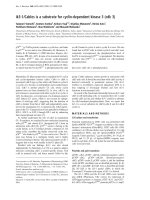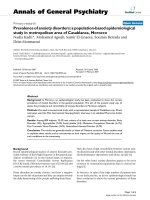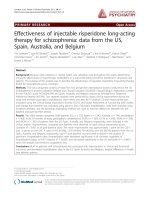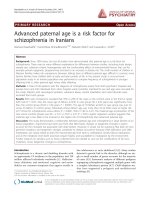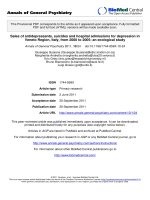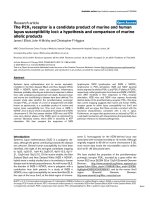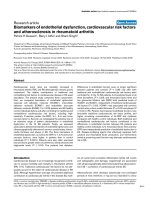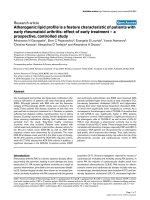Báo cáo y học: "Advanced paternal age is a risk factor for schizophrenia in Iranians" pps
Bạn đang xem bản rút gọn của tài liệu. Xem và tải ngay bản đầy đủ của tài liệu tại đây (251.53 KB, 6 trang )
PRIMARY RESEARCH Open Access
Advanced paternal age is a risk factor for
schizophrenia in Iranians
Morteza Naserbakht
1
, Hamid-Reza Ahmadkhaniha
2,3,4*
, Bahareh Mokri
5
and Cassandra L Smith
6
Abstract
Background: Since 1958 many, but not all studies have demonstrated that paternal age is a risk factor for
schizophrenia. There may be many different explanations for differences between studies, including study design,
sample size, collection criteria, heterogeneity and the confounding effects of environmental factors that can for
example perturb epigenetic programming and lead to an increase in disease risk. The small number of children in
Western families makes risk comparisons between siblings born at different paternal ages difficult. In contrast, more
Eastern families have children both at early and later periods of life. In the present study, a cros s-sectional
population study in an Iranian population was performed to compare frequency of schizophrenia in younger
offspring (that is, older paternal age) versus older offspring.
Methods: A total of 220 patients with the diagnosis of schizophrenia (cases) from both psychiatric hospitals and
private clinics and 220 individuals from other hospital wards (controls), matched for sex and age were recruited for
this study. Patients with neurological problem, substance abuse, mental retardation and mood disorder were
excluded from both groups.
Results: Birth rank comparisons revealed that 35% vs 24% of the cases vs the controls were in the third or upper
birth rank (P = 0.01). Also, the mean age of fathers at birth in case group (30 ± 6.26 years) was significantly more
than the control group (26.45 ± 5.64 years; P = 0.0001). The age of 76 fathers at birth in case group was over 32
versus 33 fathers in control group. Individuals whose fathers’ age was more than 32 (at birth) were at higher risk
(2.77 times) for schizophrenia versu s others (P < 0.0001, 95% CI 1.80 to 4.27). The maternal age at parturition of the
case versus controls groups was 26.1 ± 5.41 vs 25.07 ± 4.47 (P = 0.02). Logistic regression analysis suggests that
maternal age is less likely to be involved in the higher risk of schizophrenia than advanced parental age.
Discussion: This study demonstrates a relationship between paternal age and schizophrenia in large families of an
Iranian population. Arguments have been put forth that DNA bases changes or epigenetic changes in sperm
account for the increased risk associated with older fathers. However, it would not be surprising that both de novo
germline mutations and epigenetic changes contribute to disease occurrence because DNA replication and DNA
methylation are closely linked at both the macromolecular level (that is, methylation closely follows replication),
and at the metabolic level (both processes require folate), and susceptible to modulation by the environment.
Further research on samples such as those collected here are needed to sort out the contributions of de novo
mutations versus epigenetic changes to schizophrenia.
Introduction
Schizophrenia is a chronic and disabling disorder with
an approximate 1% incidence in the population, and 120
million afflicted individuals worldwide [1]. Hallucina-
tions, delusions, and emotional, cognitive, and motor
deficits are common symptoms that appear usually in
late adolescence or early adulthood [2,3]. Many studies
detected a genetic link to the disorder, although no sin-
gle or small number of genes accounts for the majority
of cases [4,5]. Systematic analyses of different pedigrees
segregating schizophrenia suggested multiple genes with
a complex inheritance pattern [6,7]. Child adoption stu-
dies have supported a polygenic and multifactorial
aetiology [8].
* Correspondence:
2
Tehran University of Medical Science, Tehran, Iran
Full list of author information is available at the end of the article
Naserbakht et al. Annals of General Psychiatry 2011, 10:15
/>© 2011 Naserbakht et al; licensee BioMed Central Ltd. This is an Open Access article dist ributed unde r the terms of the Creative
Commons Attribution License ( s/by/2.0), which pe rmits unrestricted use, distribution, and
reproduction in any me dium, provided the original work is properly cited.
Envi ronmental factors linked to schizophrenia include
winter parturition [9], maternal stress during pregnancy
[10,11], second trimester and postnatal infection, labour
and perinatal traumas, immigration, residenc y in urban
areas and so on [12,13], and paternal occupation and
age [14]. Paternal age has been linked to schi zophrenia
since 1958 [15]. Most stu dies including a recent meta-
analysis have confirmed paternal age as a risk factor for
schizophrenia [16-24], however negative results also
exist in t he literature [25]. The link between paternal
age and schizophrenia, argues that de novo changes to
DNA can lead to schizophrenia, because the sole biolo-
gical contribution of fathers to progeny is DNA. De
novo mutations are linked to neurodevelopmental disor-
ders and cancers [26,27] and may explain the high pre-
valence of schizophrenia despite the decreased fertility
of schizophrenia patient [14]
Malaspina suggested that single base pair mutations,
trinucleotide repeat expansion, or genetic imprinting
changes might be responsible for the observed effect
[28]. However, DNA replication and epigenetic changes
are closely linked at both the macromolecules level (for
example, DNA replication and global DNA methyla-
tion), and the metabolic level (for example, synthesis of
purines and deoxythymidine triphosphate (dTTP) and
S-adenosyl methionine, the cofactor that donates a
methyl group). Hence, it would not be surprising that
paternal age influences both of these as well as other
overlapping processes.
In 2002, Malaspina et al. reported that the paternal
age at birth of sporadic cases averaged 4.7 years older
than familial cases of s chizophrenia, and attributed
approximately 27% of the sporadic cases to paternal age,
and likely due to de novo mutations [14]. However, Pul-
ver et al. observed that paternal age is not different in
(1) familial versus sporadic cases, and (2) first-degree
and second-degree paternal relatives of probands, and
argued that these results did not support the linkage of
paternal age to spontaneous forms of schizophrenia
[29]. It is quite clear that studies on large families and
pre/post-index generations are important to distinguish
genetic from sporadic cases. However, it should be
noted that, if advanced paternal age is a risk factor for
schizophrenia, the frequency and coincidence of disease
would be more in children of fathers with higher age
and could be misinterpreted as genetic inheritance. This
may obscure the detection of sporadic versus familial
cases that could be overcome in part by the examining
the effects of higher birth rank, accompanied with
advanced paternal age, o n schizophrenia pathogenesis in
large families.
This study examined the relationship between paternal
age and schizophrenia in an Iranian population, a dis-
tinct cultural group not previously studied. Typical
Iranian families are large with a wide variation in pater-
nal age not typically seen in Western families. The study
of large families provides us with an opportunity to
examine the relatio nship between birth orde r, paternal
age and schizophrenia. If advanced paternal age is an
important risk factor for schizophrenia, disease fre-
quency would be greater in children with higher birth
rank as well (that is, higher paternal age). Hence, we
examined the effects of higher birth rank and advanced
paternal age on schizophrenia.
Methods
This case-control study was performed in Tehran in
2005 and 2006 recruiting 220 patients (case group) with
a diagnosis of schizophrenia from both psychiatric hos-
pital s and private clinics. The diagnosis was made based
on Diagnostic and Statistical Manual of Mental Disor-
ders, fourth edition (DSM-IV) criteria in a semistruc-
tured interview by two psychiatrists. The control group
was made up of 220 individuals from non-psychiatric
hospital wards of the same district, matched for sex (P
=0.84,c
2
test) and age (P = 0.37, t test) versus the case
group. Individuals with any neurological problem, sub-
stance abuse, mental retardation or mood disorder were
excluded from the case and control groups. Patients in
an acute psychotic phase were excluded because of their
inability to give consent. No organic problems were
identified in any patients with schizophren ia by medical
examinations . All cases and controls completed consent
forms and data was collected on each subjected by
trained medical students completing two instruments.
The demographic questionnaire recorded sex, employ-
ment, education, paternal age, maternal age, paternal
and maternal age at parturition, family history of psy-
chotic disorders, number of children, birth rank within
siblings, and age of disease onset. Both the patients and
their carers were asked about the presence of similar
disorders in first-degree and second-degree relatives.
Those with evidence for positive family history under-
went for further evolution by contacting their psychia-
trist, inspecting their medical records or structured
interview of the subjects and their carers in order to
confirm or rule out the presence of mental diseases.
TheseconddiagnosticinstrumentwastheStructured
Clinical Interview for DSM Disorders (SCID), previously
validated for diagnosis of schizophrenia in the Iranian
population.
Differences between study groups were examined
using the c
2
test for categorical variables, and an inde-
pendent sample t test (or Mann-Whitney U test) for
continuous variables. Probability values of P < 0.05 were
considered statistically significant. Multiple logistic
regression analysis was performed with adjustment for
independent association of all factors with schizophrenia
Naserbakht et al. Annals of General Psychiatry 2011, 10:15
/>Page 2 of 6
as a dependent variable. One model (included all inde-
pendent variables at one stage) was developed to adjust
for covariates. The analysis was performed using SPSS
software (V.11.5; SPSS, Chicago, IL, USA).
Results
A greater number o f cases (Table 1) had a birth rank of
≥3 versus controls (35% versus 24%, P = 0.01, OD = 1.7,
95% CI 1.12 to 2.5). The difference in the occurrence of
psychiatric disorders, including schizophrenia, schizoaf-
fective disorder and major mood disorders (unipolar
and bipolar disor der) in first-degree relatives was signifi-
cant in case versus control groups (P = 0.04): 20.5% ver-
sus 13.2%, respectively (Table 1).
Paternal age at parturition of the proband was signifi-
cantly different between the case and control groups.
For instance, the mean paternal age at birth w as 30 ±
6.26 versus 26.45 ± 5.64, in case versus control groups,
respectively (P = 0.0001) (Tables 1 and 2). A signifi-
cantly higher number of fathers with an age of ≥32 were
in the case group versus the control group (Table 3).
Analysis of the paternal age distribution (Figure 1)
revealed that the fathers of the case group tended to
have children at an earlier age, but that a greater
number (76, 35%) of cases’ fath ers age were ≥32, than
those in control group (n = 33, 15%). Individuals with
fathers’ ages at birth ≥32 were 2.77 times at higher risk
for schizophrenia (P < 0.0001), OR = 3.7 (95% CI 1.9 to
7.3). The mean age of mothers at birth was marginally
different (P = 0.02) between the case and control groups
(26 versus 25.07, respectively). Logistic regressi on analy-
sis (Table 4), adjusting for the effect of maternal age,
birth rank and family history, indicated that paternal age
is an independent predisposing factor to schizophrenia;
its OR was 3.78 (95% CI 1.9 to 7.3).
This case-control study providing data on a previously
unexplored Iranian populatio n supports the hypothesis
that advanced paternal age and a birth rank of higher
than 3 (that is, higher age of father at birth) are linked
to schizophrenia pathogenesis.
Discussion
Our results linking advanced paternal age to schizophre-
nia are comparable to observations in other populations.
Further, logistic regression analysis has suggested that
higher birth rank along with advanced paternal age is
more of a risk factor for schizophrenia than maternal
age. Birth rank and short birth interval were previously
found t o be risk factors for schizophrenia [30-32]. The
effect of higher birth order/rank may reflect the costs of
childbearing on a mother’s long-term health, as Chris-
tensen et al. analysing twin data found support for the
proverb ‘atooth,achild’ [33]. Higher birth rank effects
may also be a function of advanced paternal and/or
maternal age. Along these lines, our study of large
families provides evidence for the first time that the
relationship between birth order/rank and schizophrenia
may be due to paternal age. In fact, as advanced pater-
nal age was a risk factor for schizophrenia, the disease
frequency was greater in children with higher birth rank
as well (that is, higher paternal age). Higher birth rank
(and advanced paternal age) may account for the coin ci-
dence of disease in multiple siblings, whereas such coin-
cidences are taken as evidence for genetic inheritance.
However, paternal age effects on schizophrenia patho-
genesis may be mediated through both genetic and/or
epigenetic mechanisms [34,35].
Epigenetics refers to heritable but potentially rev ersi-
ble changes in DNA methylation, RNA (editing and
interference), and protein (for ex ample, histone) modifi-
cation and provide mechanisms for the environment to
interact with the genome [36]. The multiplicity of tar-
gets and modifications linked to epigenetic program-
ming suggests that perturbations to such pathways are
likely to account for a large amount of phenotypic varia-
tions. Advanced paternal age is associated w ith an ele-
vated incidence of environmental exposures that may
affect the spermatozoid epigenetic memory. These
Table 1 Demographic characteristics of cases and
controls
Cases
(%)
Controls
(%)
P
value
Sex:
Male 62.7 61.8 0.84
a
Female 37.3 38.2
Education:
Illiterate 3.6 5 0.87
a
Lower than diploma level 48.2 49.5
Diploma 39.5 35.5
Higher than diploma 86 10
Paternal age at parturition (mean ±
SD)
30.5 ±
6.2
26.4 ± 5.6 0.001
b
Maternal age at parturition (mean ±
SD)
25 ± 4.5 26.1 ± 5.4 0.02
c
Familial history of major psychiatric
disorder:
Yes 45
(20.5%)
29(13.2%) 0.041
a
No 155
(79.5%)
171(86.8%)
Birth rank
1 48 (21.8) 61 (27.7) 0.037
b
2 95 (43.2) 106 (48.2)
≥3 77 (35%) 53 (24.1)
P values < 0.05 were considered statistically significant.
a
c
2
test;
b
Mann-Whitney U test;
c
t test.
Naserbakht et al. Annals of General Psychiatry 2011, 10:15
/>Page 3 of 6
epigenetic changes could be the underlying mechanisms
of paternal age effects on schizophrenia pathogenesis.
About 50% of monozygotic (aka ident ical) t wins
afflicted by disease and starting life with identical gen-
omes are discordant for schizophrenia, and when c on-
cordant they do not have the same psychiatric
phenotypes [1]. Additionally, all children of monozygotic
twins concordant or discordant for schizophrenia have
the same elevated probability of b ecoming ill [37,38].
These o bservations suggest that genetic susceptibility is
transmitted to offspring, but environmental factors also
contribute in disease occurrence and presentation. An
elevated somatic mutation rate in twins discordant for
schizophrenia w as detected around simple trinucleotide
repeat sequences, for example, (CAG)
n
[39]. It is of note
that this study was limited to (CAG)
n
repeat occur-
rences, and we do not know whether the increased
mutation rate extends to other sequences. However,
other studies have also de tected an increase in neuronal
aneuploidies in schizophrenic brains [40,41]. Several
groups have suggested that t he genetic-environmental
linkage reflects the need for ‘two-hits’ (genetic plus
somatic changes) to DNA. Other studies have shown
that genetic and epigenetic changes occur with age
[42,43], and epigenetic differences exist between mono-
zygotic twins [44,45].
In sperm, dominant and codominant base change
mutations will impact progeny and subsequent genera-
tions in a simple Mendelian fashion. A recessive muta-
tion will not be detected in progeny (except occasionally
when a second mutated allele is present) unless the tar-
get gene is maternally imprinted and silenced. Epige-
netic changes at imprinted genes could lead to
inappropriate expression or lack of expression. The
effects on subsequent generations will be dependent o n
the parental origin of the change. Further, epigenetic
DNA methylation is reset during passage thro ugh the
germline and during embryonic and post natal develop-
ment; hence, it is not clear what chang es will be passed
to subsequent generations [36].
The dissection of the paternal age effect in large
families is advantageous given the plethora of potential
DNA changes and the consequences for subsequent gen-
erations. The paternal age effect may be due to inade-
quate nutrition and/or exposure to environmental toxins
during spermatogenesis. For instance, it is estimated that
30% of American diets are deficient in folate [46,47], a
nutrient required for the biosynthesis of TTP and DNA
synthesis as well as purine nucl eotides that are necessary
for DNA and RNA synthe sis and other cellular processes
(for example, epigenetic changes to RNA and proteins,
energy transduction, and signally). The success of genetic
studies on rare human disease has prompted research on
complex common disease to focus on genetic approaches
Table 2 Analysis of the effect of paternal age on cases (n = 220) and controls (n = 220)
Estimate Standard error Wald Degrees of freedom Significance 95% CI
Lower bound Upper bound
Family history 0.458 0.268 2.921 1 0.087 0.387 1.702
Birth rank 01 sFebruary 0.281 0.355 0.626 1 0.429 0.984 0.984
3.3+ 0.286 0.317 0.817 1 366 0.415 0.415
Paternal age 32+ 1.425 0.39 13.336 1 0 0.334 0.334
Maternal age 32+ -0.258 0.421 0.376 1 0.54 2.189 2.189
Table 3 Sample classes as a function of parental or
maternal age at birth
Group Parental age at birth, n (%) Total (P =
0.065)
Paternal Maternal
<32
years
>32
years
<32
years
>32
years
Cases 144 (76) 76 (34.5) 195 (88.5) 25 (11.5) 220 (100)
Controls 187 (85) 33 (15) 206 (93.5) 14 (6.5) 220 (100)
Figure 1 Distribution of paternal age in case and control
subjects.
Naserbakht et al. Annals of General Psychiatry 2011, 10:15
/>Page 4 of 6
while largely ignoring environmental factors that have
the potential to change not only DNA but also cause epi-
genetic changes to DNA, RNA and proteins. For
instance, paternal age and occupations linked to schizo-
phrenia in progeny may involve exposures that induce
oxidative stress and impact folate metabo lism [48]. A
comprehensive understanding of schizophrenia and other
common complex diseases requires studies on the inter-
action of the environment with specific genotypes, some
predisposed, to severe illness. Such studies are required
as several preventable known environmental and nutri-
tional factors (for example, folic acid deficiency) can
induce epigenetic alterations that may impact the quality
of human life in general.
Author details
1
Social Medicine, Mental Health Research Center, Tehran University of
Medical Sciences, Tehran, Iran.
2
Tehran University of Medical Science, Tehran,
Iran.
3
Mental Health Research Center, Tehran University of Medical Sciences,
Tehran, Iran.
4
Tehran Psychiatric Institute, Tehran, Iran.
5
Department of
Internal Medicine, National Research Institute of Tuberculosis and Lung
Disease (NRITLD), Masih Daneshvari Hospital, Shahid Beheshti University. M.C,
Iran.
6
Biomedical Engineering Department, Boston University, Boston MA,
USA.
Authors’ contributions
H-RA designed the study, collected clinical sample data and drafted the
manuscript. BM participated in sample collection. MN performed data
analysis and CLS contributed to the editing and writing of the manuscript.
All authors read and approved the final manuscript.
Competing interests
The authors declare that they have no competing interests.
Received: 29 April 2010 Accepted: 24 April 2011
Published: 24 April 2011
References
1. Saddock B, Saddock V: Kaplan and Saddock’s Comprehensive Textbook of
Psychiatry Philadelphia, PA: Lippincott Williams & Wilkins; 2005, 1330-1395.
2. Murray CJ, Lopez AD: The Global Burden of Disease Cambridge, MA: Harvard
University Press; 1996.
3. McLeen VA: Healthy People 2000. Washington, DC: US Department of
Health and Human Services/International Medical Publishing; 2000.
4. Kato C, Petronis A, Okazaki Y, Tochigi M, Umekage T, Sasaki T: Molecular
genetic studies of schizophrenia: challenges and insights. Neurosci Res
2002, 43:295-304.
5. Abdolmaleky HM, Thiagalingam S, Wilcox M: Genetics and epigenetics in
major psychiatric disorders: dilemmas, achievements, applications, and
future scope. Am J Pharmacogenomics 2005, 5:149-160.
6. Faraone SV, Brown CH, Glatt SJ, Tsuang MT: Preventing schizophrenia and
psychotic behaviour: definitions and methodological issues. Can J
Psychiatry 2002, 47:527-537.
7. Ban TA: Neuropsychopharmacology and the genetics of schizophrenia: a
history of the diagnosis of schizophrenia. Prog Neuropsychopharmacol Biol
Psychiatry 2004, 28:753-762.
8. Beckmann H, Franzek E: The genetic heterogeneity of “schizophrenia”.
World J Biol Psychiatry 2000, 1:35-41.
9. Torrey EF, Miller J, Rawlings R, Yolken RH: Seasonality of births in
schizophrenia and bipolar disorder: a review of the literature. Schizophr
Res 1997, 28:1-38.
10. Khashan AS, Abel KM, McNamee R, Pedersen MG, Webb RT, Baker PN,
Kenny LC, Mortensen PB: Higher risk of offspring schizophrenia following
antenatal maternal exposure to severe adverse life events. Arch Gen
Psychiatry 2008, 65:146-152.
11. Malaspina D, Corcoran C, Kleinhaus KR, Perrin MC, Fennig S, Nahon D,
Friedlander Y, Harlap S: Acute maternal stress in pregnancy and
schizophrenia in offspring: a cohort prospective study. BMC Psychiatry
2008, 8:71.
12. Compton MT: Considering schizophrenia from a prevention perspective.
Am J Prev Med 2004, 26:178-185.
13. McGrath JJ: The surprisingly rich contours of schizophrenia
epidemiology. Arch Gen Psychiatry 2007, 64:14-16.
14. Malaspina D, Corcoran C, Fahim C, Berman A, Harkavy-Friedman J, Yale S,
Goetz D, Goetz R, Harlap S, Gorman J: Paternal age and sporadic
schizophrenia: evidence for de novo mutations. Am J Med Genet 2002,
114:299-303.
15. Johanson E: A
study of schizophrenia in the male. Acta Psychiatrica
Neurological Scandinavica 1958, 33(Suppl 125):7-107.
16. Hare EH, Moran PA: Raised parental age in psychiatric patients: evidence
for the constitutional hypothesis. Br J Psychiatry 1979, 134:169-177.
17. Brown AS, Schaefer CA, Wyatt RJ, Begg MD, Goetz R, Bresnahan MA,
Harkavy-Friedman J, Gorman JM, Malaspina D, Susser ES: Paternal age and
risk of schizophrenia in adult offspring. Am J Psychiatry 2002,
159:1528-1533.
18. Dalman C, Allebeck P: Paternal age and schizophrenia: further support
for an association. Am J Psychiatry 2002, 159:1591-1592.
19. Zammit S, Allebeck P, Dalman C, Lundberg I, Hemmingson T, Owen MJ,
Lewis G: Paternal age and risk for schizophrenia. Br J Psychiatry 2003,
183:405-408.
Table 4 Stepwise analysis of the effect of paternal age on cases, controls
B Standard error Significance Exp(B) 95% CI for Exp(B)
Lower Upper
Step 1 Birth rank 0.313 0.131 0.017 1.368 1.058 1.769
Constant -0.642 0.285 0.025 0.526
Step 2 Birth rank 0.237 0.142 0.096 1.268 0.959 1.676
Family history 0.481 0.263 0.067 1.618 0.967 2.707
Maternal age 0.387 0.377 0.304 1.473 0.704 3.083
Constant -0.599 0.297 0.044 0.550
Step 3 Birth rank -0.115 0.169 0.496 0.891 0.640 1.241
Family history 0.444 0.268 0.098 1.559 0.922 2.638
Maternal age -0.374 0.431 0.386 0.688 0.296 1.602
Paternal age 1.329 0.336 0.000 3.778 1.955 7.304
Constant -0.123 0.321 0.703 0.885
Naserbakht et al. Annals of General Psychiatry 2011, 10:15
/>Page 5 of 6
20. Byrne M, Agerbo E, Ewald H, Eaton WW, Mortensen PB: Parental age and
risk of schizophrenia: a case-control study. Arch Gen Psychiatry 2003,
60:673-678.
21. Sipos A, Rasmussen F, Harrison G, Tynelius P, Lewis G, Leon DA, Gunnell D:
Paternal age and schizophrenia: a population based cohort study. BMJ
2004, 329:1070.
22. El-Saadi O, Pedersen CB, McNeil TF, Saha S, Welham J, O’Callaghan E,
Cantor-Graae E, Chant D, Mortensen PB, McGrath J: Paternal and maternal
age as risk factors for psychosis: findings from Denmark, Sweden and
Australia. Schizophr Res 2004, 67:227-236.
23. Tsuchiya KJ, Takagai S, Kawai M, Matsumoto H, Nakamura K, Minabe Y,
Mori N, Takei N: Advanced paternal age associated with an elevated risk
for schizophrenia in offspring in a Japanese population. Schizophr Res
2005, 76:337-342.
24. Wohl M, Gorwood P: Paternal ages below or above 35 years old are
associated with a different risk of schizophrenia in the offspring. Eur
Psychiatry 2007, 22:22-26.
25. Malama IM, Papaioannou DJ, Kaklamani EP, Katsouyanni KM, Koumantaki IG,
Trichopoulos DV: Birth order sibship size and socio-economic factors in
risk of schizophrenia in Greece. Br J Psychiatry 1988, 152:482-486.
26. Zhang Y, Kreger BE, Dorgan JF, Cupples LA, Myers RH, Splansky GL,
Schatzkin A, Ellison RC: Parental age at child’s birth and son’s risk of
prostate cancer. The Framingham Study. Am J Epidemiol 1999,
150:1208-1212.
27. Hemminki K, Kyyrönen P: Parental age and risk of sporadic and familial
cancer in offspring: implications for germ cell mutagenesis. Epidemiology
1999, 10:747-751.
28. Malaspina D: Paternal factors and schizophrenia risk: de novo mutations
and imprinting. Schizophr Bull 2001, 27:379-393.
29. Pulver AE, McGrath JA, Liang KY, Lasseter VK, Nestadt G, Wolyniec PS: An
indirect test of the new mutation hypothesis associating advanced
paternal age with the etiology of schizophrenia. Am J Med Genet B
Neuropsychiatr Genet 2004, 124B:6-9.
30. Bathaee H, Djalili A, Azardagan F: Birth order and family size in
schizophrenia. Acta Med Iran 1977, 19(2):155-66.
31. Gaughran F, Blizard R, Mohan R, Zammit S, Owen M: Birth order and the
severity of illness in schizophrenia. Psychiatry Res 2007, 150:205-210.
32. Smits L, Pedersen C, Mortensen P, van Os J: Association between short
birth intervals and schizophrenia in the offspring. Schizophr Res 2004,
70:49-56.
33. Christensen K, Gaist D, Jeune B, Vaupel JW: A tooth per child? Lancet 1998,
352:204.
34. Perrin MC, Brown AS, Malaspina D: Aberrant epigenetic regulation could
explain the relationship of paternal age to schizophrenia. Schizophr Bull
2007, 33:1270-1273.
35. Malaspina D, Perrin M, Kleinhaus KR, Opler M, Harlap S: Growth and
schizophrenia: aetiology, epidemiology and epigenetics. Novartis Found
Symp 2008, 289:196-203.
36. Abdolmaleky HM, Smith CL, Faraone SV, Shafa R, Stone W, Glatt SJ,
Tsuang MT: Methylomics in psychiatry: Modulation of gene-environment
interactions may be through DNA methylation. Am J Med Genet B
Neuropsychiatr Genet 2004, 15:51-59.
37. Gottesman II, Bertelsen A: Confirming unexpressed genotypes for
schizophrenia. Risks in the offspring of Fischer’s Danish identical and
fraternal discordant twins. Arch Gen Psychiatry 1989, 46:867-872.
38. Kringlen E, Cramer G: Offspring of monozygotic twins discordant for
schizophrenia. Arch Gen Psychiatry 1989, 46:873-877.
39. Nguyen GH, Bouchard J, Boselli MG, Tolstoi LG, Keith L, Baldwin C,
Nguyen NC, Schultz M, Herrera VL, Smith CL: DNA stability and
schizophrenia in twins. Am J Med Genet B Neuropsychiatr Genet 2003,
120B:1-10.
40. Kunugi H, Lee KB, Nanko S: Cytogenetic findings in 250 schizophrenics:
evidence confirming an excess of the X chromosome aneuploidies and
pericentric inversion of chromosome 9. Schizophr Res 1999, 40:43-47.
41. Yurov YB, Vostrikov VM, Vorsanova SG, Monakhov VV, Iourov IY: Multicolor
fluorescent in situ hybridization on post-mortem brain in schizophrenia
as an approach for identification of low-level chromosomal aneuploidy
in neuropsychiatric diseases. Brain Dev 2001, 23(Suppl 1):S186-190.
42. Tamura Y, Kunugi H, Ohashi J, Hohjoh H: Epigenetic aberration of the
human REELIN gene in psychiatric disorders. Mol Psychiatry 2007, 12:519,
593-600.
43. Abdolmaleky HM, Smith CL, Zhou JR, Thiagalingam S: Epigenetic
modulation of reelin function in schizophrenia and bipolar disorders.
Reelin Glycoprotein, Biology, Structure and Roles in Health and Disease
London, UK: Springer; 2008.
44. Petronis A, Gottesman II, Kan P, Kennedy JL, Basile VS, Paterson AD,
Popendikyte V: Monozygotic twins exhibit numerous epigenetic
differences: clues to twin discordance? Schizophr Bull 2003, 29:169-178.
45. Petronis A: The origin of schizophrenia: genetic thesis, epigenetic
antithesis, and resolving synthesis. Biol Psychiatry 2004, 15:965-970.
46. Nath SD, Koutoubi S, Huffman FG: Folate and vitamin B12 status of a
multiethnic adult population.
J Natl Med Assoc 2006, 98:67-72.
47. Affenito SG, Thompson DR, Franko DL, Striegel-Moore RH, Daniels SR,
Barton BA, Schreiber GB, Schmidt M, Crawford PB: Longitudinal assessment
of micronutrient intake among African-American and white girls: The
National Heart, Lung, and Blood Institute Growth and Health Study. J
Am Diet Assoc 2007, 107:1113-1123.
48. Waly M, Olteanu H, Banerjee R, Choi SW, Mason JB, Parker BS, Sukumar S,
Shim S, Sharma A, Benzecry JM, Power-Charnitsky VA, Deth RC: Activation
of methionine synthase by insulin-like growth factor-1 and dopamine: a
target for neurodevelopmental toxins and thimerosal. Mol Psychiatry
2004, 4:358-70.
doi:10.1186/1744-859X-10-15
Cite this article as: Naserbakht et al.: Advanced paternal age is a risk
factor for schizophrenia in Iranians. Annals of General Psychiatry 2011
10:15.
Submit your next manuscript to BioMed Central
and take full advantage of:
• Convenient online submission
• Thorough peer review
• No space constraints or color figure charges
• Immediate publication on acceptance
• Inclusion in PubMed, CAS, Scopus and Google Scholar
• Research which is freely available for redistribution
Submit your manuscript at
www.biomedcentral.com/submit
Naserbakht et al. Annals of General Psychiatry 2011, 10:15
/>Page 6 of 6
